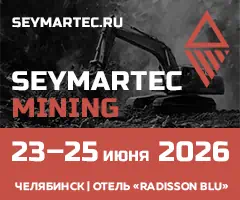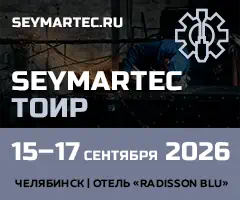Methods for determining rockburst in mining workings
 A.S. Potokin, A.K. Pak
A.S. Potokin, A.K. Pak
Mining Institute – Subdivision of the Federal Research Centre “Kola Science Centre of the Russian Academy of Sciences” (MI KSC RAS), Apatity, Russian Federation
Russian Mining Industry №5 / 2022 р. 139-143
Abstract: Insufficient attention is currently paid to experimental studies aimed to assess the rock strength. Therefore, the objective of this paper is to study the changes in rock properties in the main fracture zone under compression and stretching conditions. The research paper reviews methods to assess fracture activity in mine workings prone to rock bursts. The possibility of detecting near-fracture changes in the rock mass of the mine workings has been determined using acoustic and electromagnetic emission detection devices (equipment) currently available on the market. Work has been carried out to determine acoustic emission (AE) and electromagnetic radiation (EMR) parameters during uniaxial and triaxial loading of rock samples.
Keywords: determining of rockburst, mining workings, acoustic emission, electromagnetic radiation
Acknowledgments: The work was carried out within the framework of the work program on the topic “Studying the mechanism of formation and substantiation of criteria for loss of geomechanical stability during large-scale mining” (Code FMEZ-2022-0004).
For citation: Potokin A.S., Pak A.K. Methods for determining rockburst in mining workings. Russian Mining Industry. 2022;(5): 139–143. https://doi.org/10.30686/1609-9192-2022-5-139-143
Article info
Received: 03.09.2022
Revised: 26.09.2022
Accepted: 26.09.2022
Information about the authors
Alexander S. Potokin – Researcher of the Mining Institute – Subdivision of the Federal Research Centre “Kola Science Centre of the Russian Academy of Sciences” (MI KSC RAS), Apatity, Russian Federation; e-mail: This email address is being protected from spambots. You need JavaScript enabled to view it.
Alexander K. Pak – Researcher of the Mining Institute – Subdivision of the Federal Research Centre “Kola Science Centre of the Russian Academy of Sciences” (MI KSC RAS), Apatity, Russian Federation
Introduction
Studies on the registration of acoustic emission (AE) and electromagnetic radiation (EMR) were carried out in order to assess the stress-strain state of rock samples for the subsequent prediction of manifestations of rock pressure in a dynamic form. Analysis of EMR and AE signals on rock samples and in mine workings showed good agreement between the obtained data. The possibility of using EMR and AE to control the stressstrain state of sections of a rock mass and predict damage in a dynamic form in real time is determined.
The relevance of studying the parameters of acoustic and electromagnetic radiation is due to the need for mining enterprises to have an operational (express) method for assessing changes in the stress-strain state of rock masses and predicting their shock hazard. Interest in the method of estimating AE parameters in Russia arose in the late 1960s and early 1970s. It was then that the understanding came that this method could become a powerful tool for studying and controlling the processes of formation and development of defects in solids. The second stage in the development of the AE method took place in the early and mid-1990s, when scientific studies of AE began to be applied in the practice of industrial non-destructive testing. Interest in the method of estimating EMR parameters as an indicator of rock destruction increased in the 1970s in connection with the problem of earthquake prediction. At an early stage of the practical use of the method at the Tomsk Polytechnic Institute under the guidance of Professor A.A. Vorobyov in laboratory conditions, EMR was recorded during mechanical action on dielectric materials [1]. Subsequently, the EMR method was studied both in Russia and abroad in the deformation of various materials, including alkali-halide crystals, metals and alloys, single crystals, rocks, and ice. The most interesting results were obtained during laboratory and field studies at the Institute of Physics of the Earth. O.Yu. Schmidt of the Russian Academy of Sciences (G.A. Sobolev, A.V. Ponomarev, M.B. Gokhberg), at the Tomsk Polytechnic University (A.A. Vorobyov, R.M. Gold, Sh.R. Mastov, Yu.P. Malyshkov , L.V. Yavorovich, A.A. Bespalko, V.N. Salomatin, V.N. Salnikov), at the Institute of Mining of the Siberian Branch of the Russian Academy of Sciences (M.V. Kurlenya, V.N. Oparin, G.E. Yakovitskaya, G.I. Kulakov, A.G. Vostretsov), at the Research Institute of Mining Geomechanics and Mine Surveying "VNIMI" (V.I. Frid, A.P. Skakun, V.M. Proskuryakov, A.P. Shabarov, S. F. Panin, S.N. Mulev) [2–8]. Similar studies were also carried out abroad – in Georgia, Armenia, Kazakhstan, Uzbekistan, Ukraine and Kyrgyzstan, the USA, Canada, Japan, China, India, Israel and other countries [9–11]. From numerous laboratory studies, it was found that EMR is associated with the development of micro-cracking processes and occurs in the process of destruction of materials. This feature of EMR is manifested both at the level of laboratory tests and for large-scale studies, including man-made and natural earthquakes.
Determination of acoustic emission and electromagnetic radiation parameters
The first studies on rock burst prediction using AE and EMR methods at the Mining Institute of the KSC RAS (Apatity) were carried out in 1989. As part of the research work, a methodology was developed for local assessment of the rockburst hazard of rocks and ores in mine workings in terms of AE and EMR parameters, methods were developed for assessing the control and condition of hazardous areas of the massif using seismic tomography methods that are adapted to the conditions and tasks of apatite mines. The some results of the research are published in scientific articles [12–14]. In 2017, at the Mining Institute of the KSC RAS, studies were carried out to test a prototype of the ANGEL-M device (developed by VNIMI) to assess the level of geodynamic hazard of the “Oleniy Ruchey” deposit, which is dangerous in terms of rock bursts. According to the results of EMR measurements in mine workings, it was possible to identify a trend of insignificant changes in the EMR level in areas with visual intense manifestations of rock pressure. For the period from 2019 to present At the Mining Institute of the KSC RAS, work is underway to determine the parameters of AE and EMR under uniaxial and volumetric loading of rock samples [15; 16]. Studies on the registration of AE and EMR were carried out in order to assess the stressstrain state of rock samples for the subsequent prediction of manifestations of rock pressure in a dynamic form. The research was carried out in two stages. At the first stage, AE and EMR were registered on rock samples in laboratory conditions. At the second stage, studies were carried out in natural conditions of mine workings.
Laboratory studies were carried out on rock core samples taken from the deposits of the Kola region (Kovdorskoe, Olenegorskoe, Zaimandrovsky iron ore district, Khibiny massif, Lovozero, Zapolyarny). Samples of urtites, ijolites, pegmatites, staffelites, carbonatites, fenites, pyroxenites, lavochorites, as well as artificial materials – concrete samples were subjected to volumetric and uniaxial destruction.
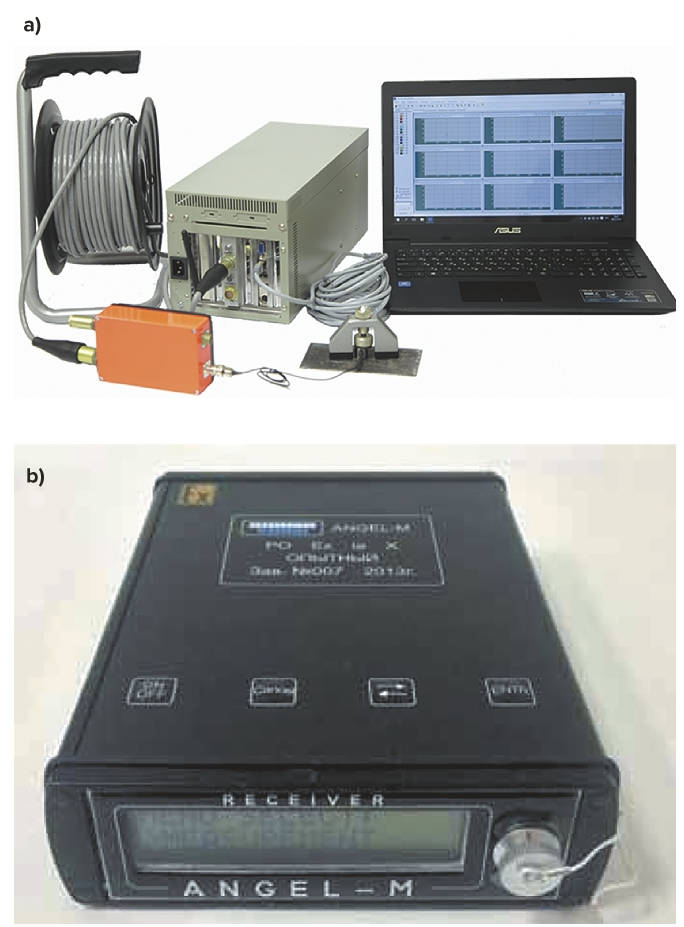 Fig. 1 (a) Acoustic emission complex A-Line DDM-1 (b) ANGEL-M device for EMR registration (developed by VNIMI)
Fig. 1 (a) Acoustic emission complex A-Line DDM-1 (b) ANGEL-M device for EMR registration (developed by VNIMI)
Рис. 1 (a) Акустико-эмиссионный комплекс A-Line DDM-1 и (b) комплекс ANGEL-M для регистрации электромагнитной эмиссии (разработка ВНИМИ)
Uniaxial and volumetric compression tests were carried out using a hydraulic press MTS-816 Rock Test System. The ultimate load of rock destruction under uniaxial compression ranged from 125 kN (for carbonatite samples) to 920 kN (for pyroxenite samples). Under volume compression, the ultimate fracture load ranged from 540 kN to 1000 kN (for lavochorrite samples) at a lateral pressure of 10, 20, 30 kN. The size and weight of the samples under uniaxial compression averaged – h = 120 mmd = 60 mm up to 1000 gr. For volume destruction h = 100 mm d = 47 mm, weight up to 500 gr. Registration of AE signals was carried out using a multichannel modular acoustic emission complex with distributed acquisition and digital data transmission A-Line DDM-1 (6 channels). Acoustic emission transducers PK 30–300 kHz and GT 50–250 kHz were used to register AE. To calibrate the acoustic emission transducers, we used an elastic wave excitation simulator that creates acoustic emission signals in the controlled object. During registration of AE parameters under uniaxial loading of samples at a constant rate of 0.2 kN/s, the possibility of predicting their destruction in real time based on the results of recorded acoustic emission events was revealed. It has been established that for especially strong rocks prone to dynamic destruction (tensile strength of about 200 MPa), at the time of loading, at least three times there are zones of high activity of acoustic events lasting from 2 to 5 minutes with an amplitude of up to 94 dB and the number of events up to 3000 per second. Also, at the time of the burst of activity of acoustic signals, a high activity of electromagnetic radiation was recorded (Fig. 2)
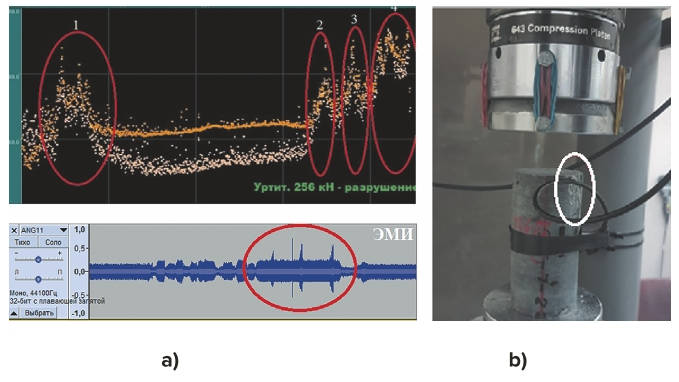 Fig. 2 (a) AE and EMR signals recorded during uniaxial compression of an urtite sample (b) manifestation of dynamic fractures in the sample at a load of 538 kN
Fig. 2 (a) AE and EMR signals recorded during uniaxial compression of an urtite sample (b) manifestation of dynamic fractures in the sample at a load of 538 kN
Рис. 2 (a) Сигналы АЭ и ЭМИ, зарегистрированные во время одноосного сжатия образца уртита (b) развитие динамических разрушений в образце при нагрузке 538 кН
To register AE signals in natural conditions, a portable two-channel non-destructive testing device “UNISCOP” was used. Registration was carried out in areas of the massif with pronounced dynamic manifestations of rock pressure and in areas without such manifestations (Fig. 3).
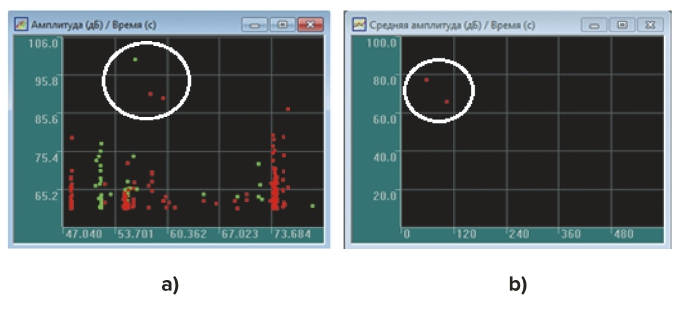 Fig. 3 Registration of AE signals in the mine workings of Zapolyarny, mine “Severny” (a) AE in the area with visible signs of dynamic manifestation of rock pressure; (b) AE in the area without dynamic manifestation of rock pressure
Fig. 3 Registration of AE signals in the mine workings of Zapolyarny, mine “Severny” (a) AE in the area with visible signs of dynamic manifestation of rock pressure; (b) AE in the area without dynamic manifestation of rock pressure
Рис. 3 Регистрация сигналов АЭ в горных выработках г. Заполярный, рудник "Северный" (a) АЭ в зоне с видимыми признаками динамического проявления горного давления; (b) АЭ в зоне без динамического проявления горного давления
The graphs presented in Figure 3 show an increased activity of AE signals in places of dynamic manifestation of rock pressure. The levels of AE signals in such places amounted to the maximum values on sensor 1 (green) – 100 dB, on sensor 2 – 90.5 dB 89.7 dB. (red). In the places of development without dynamic manifestation of rock pressure, the recorded levels of AE signals reached lower values – 77.4 dB and 65.8 dB.
In order to identify the possibility of determining zones of increased in mine workings, laboratory studies were carried out to create a model for linear and volumetric locations of AE events in rock samples. Using a Su-Nielsen source and excitation simulator that creates acoustic emission signals to simulate the propagation of a sound wave on the surface of a rectangular rock sample 500x250x200 mm in size (Fig. 4a), it was possible to locate the simulated acoustic signal with an accuracy of 1 mm.
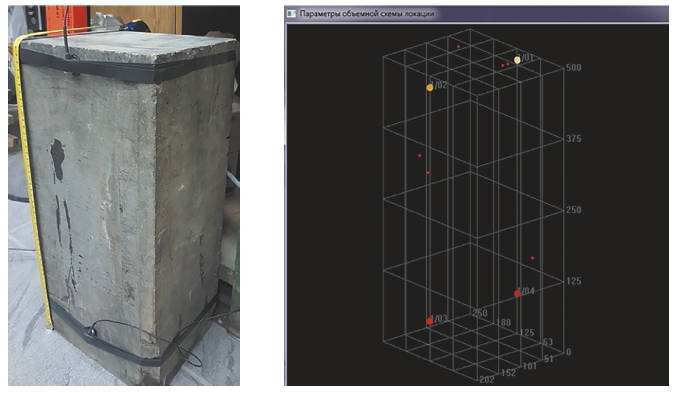 Fig. 4 Studies to determine the linear and volumetric location of AE signals on a rock sample using elastic wave excitation simulator
Fig. 4 Studies to determine the linear and volumetric location of AE signals on a rock sample using elastic wave excitation simulator
Рис. 4 Исследования по определению линейной и объемной локации сигналов АЭ на образце горной породы с использованием моделирующего устройства для возбуждения упругих волн
A 3D model of the sample was also created to determine the volumetric location of AE signals (Fig. 4b). The ongoing research is aimed at developing a methodology for determining AE sources both in the near-contour part of the mine working and in the depths of the rock mass.
Registration of EMR signals during loading of rock samples in laboratory and natural conditions was carried out using the ANGEL-M complex (VNIMI), designed to evaluate the parameters of non-stationary geophysical fields associated with the destruction of rocks. The complex allows real-time search and current control of the stress-strain state of a rock mass that is dangerous in terms of rock bursts.
In the mine workings of the city of Zapolyarny (the “Severny” mine) and the city of Norilsk (the “Skalisty” mine), AE and EMR were registered. The analysis and comparison of data obtained during the destruction of rock samples in laboratory conditions with data obtained in natural conditions was carried out. The analysis showed that there is a direct correlation between the EMR signals obtained on rock samples and in mine workings (Fig. 5).
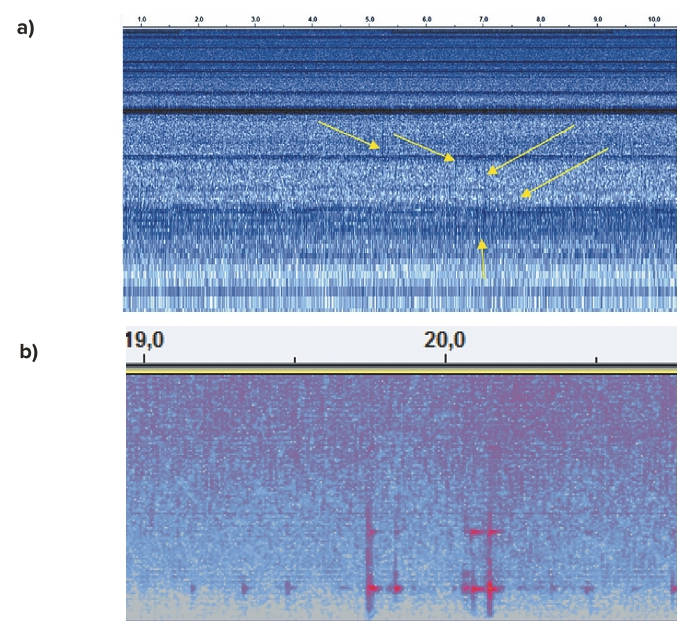 Fig. 5 Spectrograms of EMR signals: (a) In the event of the destruction of a rock sample (jolite) (b) In the development of the city of Norilsk, mine “Skalisty”
Fig. 5 Spectrograms of EMR signals: (a) In the event of the destruction of a rock sample (jolite) (b) In the development of the city of Norilsk, mine “Skalisty”
Рис. 5 Спектрограммы сигналов ЭМИ: (a) при разрушении образца породы (иолит) (b) при проходке на руднике "Скалистый", г. Норильск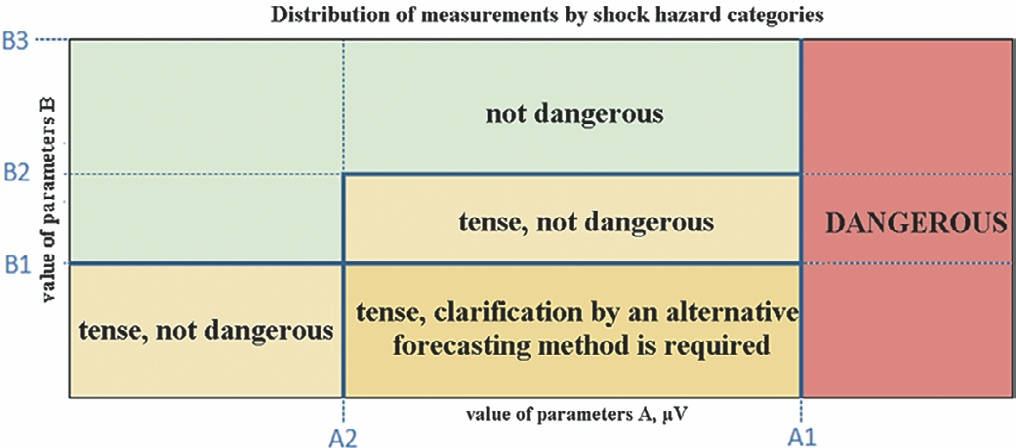 Fig. 6 Table from the software for evaluating the parameters of EMR signals to determine the impact hazard category (VNIMI)
Fig. 6 Table from the software for evaluating the parameters of EMR signals to determine the impact hazard category (VNIMI)
Рис. 6 Таблица, полученная с использованием программного обеспечения для оценки параметров сигналов ЭМИ для определения категории опасности воздействия (ВНИМИ)
To estimate the parameters of non-stationary geophysical fields associated with the destruction of rocks in mine workings and the subsequent prediction of shock hazard from the EMR signal, the software for the ANGEL-M device (developed by VNIMI) was used (Fig. 6). The results of the analysis of EMR signals and the prediction of rockburst hazard in the studied objects (mine working in Norilsk, mine “Skalisty”) of mining workings are shown in the Figure 7.
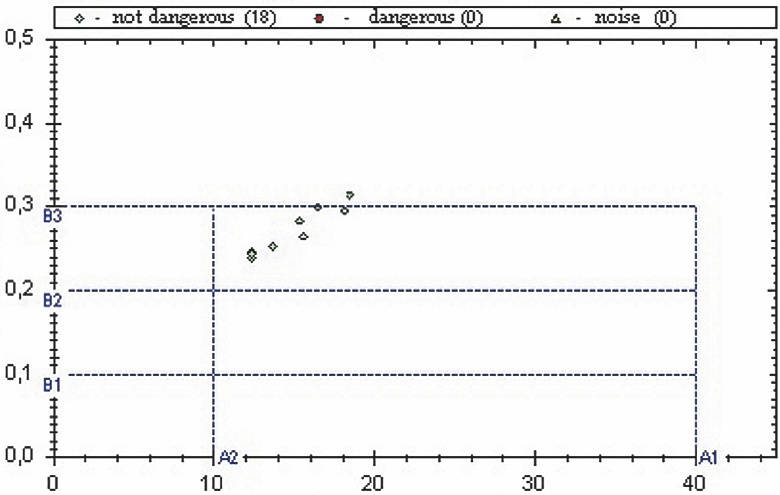 Fig. 7 The result of the rockburst hazard assessment based on the EMR signal in the mine working in Norilsk, the Skalisty mine. NOT DANGEROUS
Fig. 7 The result of the rockburst hazard assessment based on the EMR signal in the mine working in Norilsk, the Skalisty mine. NOT DANGEROUS
Рис. 7 Результат оценки опасности возникновения горных ударов на основе сигнала ЭМИ на руднике "Скалистый", г. Норильск. НЕ ОПАСНО
Conclusion
Registration of EMR signals on rock samples and in mine workings showed good agreement between the obtained data. The possibility of using EMR to control the stress-strain state of sections of a rock mass and predict destruction in a dynamic form in real time without the need to install additional equipment makes this method the most promising of all methods for instrumental assessment of rock burst.
The obtained results indicate that the development of methods for assessing the rock burst hazard based on the registration of AE and EMR signals can be a subject for further scientific research in order to develop measures for the prediction and prevention of rock bursts during the development of mineral deposits.
References
1. Vorobyov A.A., Salnikov V.N., Korovkin M.V. Observation of radio pulses during heating of crystals and minerals in vacuum. Russian Physics Journal. 1975;18(7):59–64. (In Russ.)
2. Salnikov V.N., Zavertkin S.D., Korovkin M.V. Electromagnetic and acoustic effects due to structural changes in glasses. Tomsk; 1980. 5 p.
3. Gokhberg M.B., Morgunov V.A., Pokotelov O.A. Seismoelectromagnetic phenomena. Moscow: Nauka; 1988. 169 p. (In Russ.)
4. Kurlenya M.V., Vostretsov A.G., Kulakov G.I., Yakovitskaya G.E. Registration and processing of signals of electromagnetic radiation of rocks. Novosibirsk: Siberian Branch of the Russian Academy of Sciences; 2000. 231 p. (In Russ.)
5. Kurleniya M.V., Yakovitskaya G.V., Kulakov G.I. Stages of the fracture process on the basis of electromagnetic radiation investigation. Fiziko-Texhnicheskiye Problemy Razrabbotki Poleznykh Iskopaemykh. 1991;(1):44–49. (In Russ.)
6. Bezrodny K.P., Basov A.D., Romanevich K.V. Control of stress strain state of rock mass during tunnel construction applying NEMR method. Izvestija Tulskogo Gosudarstvennogo Universiteta. Nauki o Zemle. 2011;(1):227–234. (In Russ.)
7. Mulev S.N., Starnikov V.N., Romanevich O.A. The current stage of development of the geophysical method for recording natural electromagnetic radiation (EEMI – NER). Ugol. 2019;(10):6–14. (In Russ.) https://doi.org/10.18796/0041-5790-2019-10-6-14
8. Lavrov A.V., Shkuratnik V.L., Filimonov Yu.L. Acoustic emission effect of memory in rocks. Moscow: Moscow State Mining University; 2004. 456 p. (In Russ.)
9. Bahat D., Rabinovitch A., Frid V. Tensile fracturing in rocks. Tectonofrac-tographic and electromagnetic radiation methods. Heidelberg: Springer; 2005, 569 p. (In Russ.)
10. Rabinovitch A., Frid V., Bahat D. Surface oscillations – A possible source of fracture induced electromagnetic radiation. Tectonophysics. 2007;431(1–4):15–21. https://doi.org/10.1016/j.tecto.2006.05.027
11. He J., He X., Nie B. Monitoring stressed state of coal body by electromagnetic emission. Journal of Mining and Safety Engineering. 2006;23:111–114. (In Chinese).
12. Panichkin S.A., Kozyrev A.A., Sobolev G.A., Demin V.M. Investigation of electromagnetic and acoustic emission signals as precursors of rock bursts after massive explosions at the Khibiny apatite mines. In: 6th International Seminar on Mining Geophysics. Perm; 1993, pp. 40. (In Russ.)
13. Kozyrev A.A., Panichkin S.A. Methodological provisions for the prediction of seismic events in the rock mass after massive explosions during the development of the Khibiny apatite deposits based on the data of complex registration of acoustic and electromagnetic emission signals. In: Methodological bases for monitoring the state of the rock mass and forecasting dynamic phenomena. Moscow; 1994, pp. 25–44. (In Russ.)
14. Panichkin S.A. Prediction of dynamic phenomena based on a comprehensive study of the kinetics of acoustic and electromagnetic radiation. In: Melnikov N.N. (ed.) Geomechanics in Mining in Highly Stressed Rocks. Apatity: Kola Science Center RAS; 1998. pp. 173–180. (In Russ.)
15. Potokin A.S., Kuznetcov N.N., Zemtsovskii A.V. The review of the methods of measuring the acoustic and electromagnetic emission parameters in rock masses. Transactions of the Kola Science Centre. 2019;10(5-18):132–138. (In Russ.) https://doi.org/10.25702/KSC.2307-5252.2019.5.132-138
16. Potokin A.S., Pak A.K. Study of acoustic and electromagnetic emissions under uniaxial compression of hard rock samples. Naukosfera. 2020;(11-2):86–91. (In Russ.)



